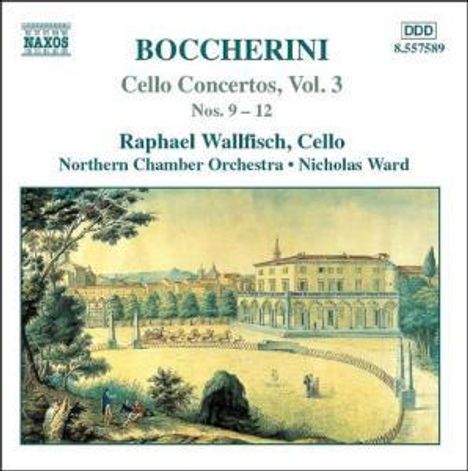Luigi Boccherini: Cellokonzerte Vol.3 auf CD
Cellokonzerte Vol.3
Herkömmliche CD, die mit allen CD-Playern und Computerlaufwerken, aber auch mit den meisten SACD- oder Multiplayern abspielbar ist.
Lassen Sie sich über unseren eCourier benachrichtigen, falls das Produkt bestellt werden kann.
(Nr. 9 in B G. 482; Nr. 10 in D G. 483; Nr. 11 in C G. 573; Nr. 12 in Es G. deest)
- Künstler:
- Raphael Wallfisch, Northern Chamber Orchestra, Nicholas Ward
- Label:
- Naxos
- Aufnahmejahr ca.:
- 2004
- UPC/EAN:
- 0747313258925
- Erscheinungstermin:
- 3.1.2005
Ähnliche Artikel
Das zwölfte Cellokonzert wurde erst 1987 in einer Bibliothek in Neapel entdeckt. Bei den zwölf bekannten Cellokonzerten handelt es sich wahrscheinlich alle um recht frühe Werke, die geschrieben wurden, bevor er sich in Madrid niederließ. Diese Werke nutzen virtuose Technik, deren herausragendes Merkmal die Verwendung extrem schneller Passagen in den allerhöchsten Lagen des Instruments ist, manchmal mit zusätzlichen Doppelgriffen, um dem Interpreten noch größere Herausforderungen zu bieten.
Das kürzlich entdeckte Konzert Nr. 12 Es-Dur, dessen erste zeitgenössische Aufführung 1987 in Wien stattfand, könnte ein späteres Datum haben (möglicherweise 1772) als die anderen Konzerte. Ob dies der Fall ist oder nicht, die Musik selbst, weniger von ornamentalen Details belastet, deutet auf eine Bewegung weg von den Manierismen des Rokoko hin zu den klareren Linien des späteren klassischen Stils hin. Im ersten Satz erreicht Boccherini eine längere bogenförmige Phrase, die durch die innere Entwicklung der einfacheren melodischen Linie artikuliert wird. Die Cellokomposition ist immer noch beängstigend anspruchsvoll, aber die Virtuosität drängt sich hier nicht auf und verdeckt nicht den strukturellen Fortschritt der Musik. Das Largo ist Boccherini in seiner emotional intensivsten Form. Auf die orchestrale Einleitung mit ihren punktierten Rhythmen und den markanten Kontrasten von Piano und Forte folgt eine gefühlvolle Kantilene für das Violoncello. Das abschließende Allegro ist ein entzückendes Rondo, dessen Hauptthema einfach und unprätentiös ist, fast wie eine Volksmelodie. Die Texturen sind hier leicht und luftig, und es gibt auch eine Klarheit und Unvermeidlichkeit der Form mit zarten harmonischen Schattierungen in den Episoden und, ungewöhnlich, aber in diesem Fall am treffendsten, keine Kadenz, die den leichten Fluss dieses Satzes zu seinem glücklichen Ende unterbricht.
Product Information
The twelfth cello concerto was only discovered in 1987 in a library in Naples. The twelve known cello concertos are all probably quite youthful works, written before he settled in Madrid. These works exploit virtuoso technique, a prominent feature of which is the use of extremely fast passage-work in the very highest registers of the instrument, sometimes with additional double-stopping to provide the performer with even greater difficulties.
The recently discovered Concerto No. 12 in E flat major, the first modern performance of which was given in Vienna in 1987, may be of a later date (possibly 1772) than the other concertos. Whether this be the case or not, the music itself, less encumbered with ornamental detail, hints at a movement away from rococo mannerisms towards the clearer lines of the later classical style. In the first movement Boccherini achieves a longer arching phrase articulated through internal development of the simpler melodic line. The cello writing is still fearsomely high but virtuosity does not obtrude itself here or obscure the structural progress of the music. The Largo is Boccherini at his most emotionally intense. The orchestral introduction with its dotted rhythms and striking contrasts of piano and forte is followed by a heartfelt cantilena for the cello. The final Allegro is a delightful Rondo, its principal theme simple and unpretentious, almost like a popular tune. The textures here are light and airy and there is also a clarity and inevitability about the form with delicate harmonic shadings in the episodes and, unusually but most aptly in this case, no cadenza to interrupt this movement’s easy flow towards its happy conclusion.
Disk 1 von 1 (CD)
-
1 Cello Concerto in B flat major, G. 482 (arr. F. Grutzmacher): I. Allegro moderato
-
2 Cello Concerto in B flat major, G. 482 (arr. F. Grutzmacher): II. Andante grazioso
-
3 Cello Concerto In B Flat Major, G. 482 (Arr. F. Grutzmacher): Iii. Rondo: Allegro
-
4 Cello Concerto in D major, G. 483: I. Allegro moderato
-
5 Cello Concerto in D major, G. 483: II. Andante lentarello
-
6 Cello Concerto In D Major, G. 483: Iii. Allegro E Con Moto
-
7 Cello Concerto in C major, G. 573: I. Maestoso
-
8 Cello Concerto in C major, G. 573: II. Largo cantabile
-
9 Cello Concerto In C Major, G. 573: Iii. Allegro Comodo
-
10 Cello Concerto in E flat major, G. deest: I. Maestoso
-
11 Cello Concerto in E flat major, G. deest: II. Largo
-
12 Cello Concerto In E Flat Major, G. Deest: Iii. Allegro











